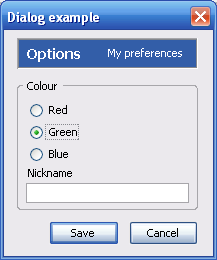This element should be used in place of the window element for dialog boxes. The buttons attribute may be used to set which buttons should appear in the dialog box. These buttons will be placed in the correct locations for the user's platform.
More information is available in the XUL tutorial and Dialogs and prompts (code snippets).
- Attributes
- buttonaccesskeyaccept, buttonaccesskeycancel, buttonaccesskeydisclosure, buttonaccesskeyextra1, buttonaccesskeyextra2, buttonaccesskeyhelp, buttonalign, buttondir, buttondisabledaccept, buttonlabelaccept, buttonlabelcancel, buttonlabeldisclosure, buttonlabelextra1, buttonlabelextra2, buttonlabelhelp, buttonorient, buttonpack, buttons, defaultButton, ondialogaccept, ondialogcancel, ondialogdisclosure, ondialogextra1, ondialogextra2, ondialoghelp, title
- Properties
- buttons, defaultButton
Examples

<?xml version="1.0"?>
<?xml-stylesheet href="chrome://global/skin/global.css" type="text/css"?>
<dialog id="donothing" title="Dialog example"
xmlns="http://www.mozilla.org/keymaster/gatekeeper/there.is.only.xul"
buttons="accept,cancel"
buttonlabelcancel="Cancel"
buttonlabelaccept="Save"
ondialogaccept="return doOK();"
ondialogcancel="return doCancel();">
<dialogheader title="Options" description="My preferences"/>
<groupbox>
<caption label="Colour"/>
<radiogroup>
<radio label="Red"/>
<radio label="Green" selected="true"/>
<radio label="Blue"/>
</radiogroup>
<label value="Nickname"/>
<textbox/>
</groupbox>
</dialog>
Attributes
activetitlebarcolor- Type: color string
- Specify background color of the window's titlebar when it is active (foreground). Moreover this hides separator between titlebar and window contents. This only affects Mac OS X.
-
defaultButton - Type: string
- Normally this attribute should not be set, but if it is, it specifies the default button in the dialog. Typically, this means that the button will be activated when the Enter key is pressed. This should be set to one of the same values as those for the
buttonsattribute.
-
inactivetitlebarcolor - Type: color string
- Specify background color of the window's titlebar when it is inactive (background). Moreover this hides separator between titlebar and window contents. This affects only on Mac OS X.
-
ondialogaccept - Type: script code
- The code in this attribute is called when the accept button is pressed, or when the
acceptDialogmethod is called. If the handler returnstrue, the dialog will indeed go away, but if it returnsfalseit will not.
-
ondialogcancel - Type: script code
- The code in this attribute is called when the "cancel" button is pressed or when the
cancelDialogmethod is called. If the routine returns true, the dialog will indeed go away, but if it returns false it will not.
-
ondialogdisclosure - Type: script code
- The code in this attribute is called when the "disclosure" button is pressed.
-
ondialogextra1 - Type: script code
- The code in this attribute is called when the first extra button is pressed.
-
ondialogextra2 - Type: script code
- The code in this attribute is called when the second extra button is pressed.
-
ondialoghelp - Type: script code
- The code in this attribute is called when the "help" button is pressed.
-
title - Type: string
- The text to appear in the title bar of the window.
Properties
-
defaultButton - Type: string
- Normally this attribute should not be set, but if it is, it specifies the default button in the dialog. Typically, this means that the button will be activated when the Enter key is pressed. This should be set to one of the same values as those for the
buttonsattribute.
Methods
-
acceptDialog() - Return type: no return value
- Accepts the dialog and closes it, similar to pressing the OK button.
-
cancelDialog() - Return type: no return value
- Cancels the dialog and closes it, similar to pressing the Cancel button.
-
centerWindowOnScreen() - Return type: no return value
- Centers the dialog on the screen.
-
getButton( type ) - Return type: button element
- Returns the
buttonelement in the dialog corresponding to the given type.
-
moveToAlertPosition() - Return type: no return value
- Moves and resizes the dialog to a position and size suitable for an alert box.
Related
- Elements
dialogheader